In the fourth part of the article, adriaticnature tried to deal with most species of medium-sized fish caught during the sea shore fishing and bringing joy from playing with light tackle. However, many fishermen, who come on vacation to the Adriatic Sea, don’t want to catch a multi-colored inhabitant of emerald salty waters solely. They want to fight and take a photo of a large sea predator as a souvenir.
Of course, fans of fishing with leger rigs and float fishing can expect catching European basses, gilthead seabreams, and other big representatives of the families of sea breams, massive morays and eels. However, adriaticnature thinks that the Adriatic provides all the possibilities to compete with the fishes, the strength of which can’t be compared with any inhabitant of fresh European water bodies.
Having mentioned the “summer” coastal predator barracuda and the “interseasonal” European bass in the first part of the article, in the previous part, adriaticnature got to describing medium-sized groupers that have much larger close relatives. adriaticnature starts the final part of the article about the sea shore fishing, which can be arranged by vacationers themselves in the course of their vacation, with the most frequently caught “big brothers”.
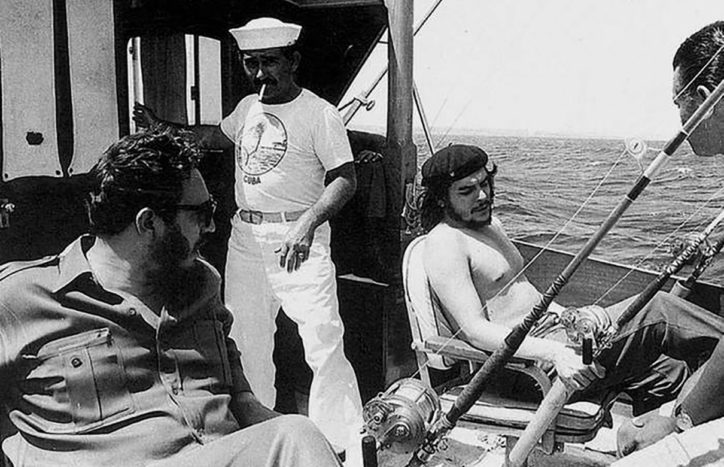
(Fidel Castro and Che Guevara marlin fishing off the coast of Cuba in 1960. thisisfishing.us)
Groupers are a fish genus of the Serranidae family, which can weigh up to 450 kilograms. Such large representatives are not found in the Adriatic Sea. However, lucky fishermen, who catch them from motorboats and boats, can expect catching fish weighing up to 60-70 kilograms.
The groupers are mostly ambush predators hiding in underwater caves, remains of sunken ships, crevices of the rocky bottom, swimming out of their shelters in search of food. Groupers are active throughout the year, but their habitat conditions hinder searching for them a little bit.
During fishing with a spinning rod from rocky shores near deep sea areas, you can expect the biting of at least two members of the family.
Goldblotch grouper, which is more often called cherna by fishermen, is a permanent inhabitant of the coastal rocky bottom of the Adriatic. This predator is found at depths down to 200 meters. I can be up to 140 centimeters long. The larger the fish is, the deeper and farther from the coast it is looking for shelter. Young groupers, weighing up to several kilograms, get out of their ambushes in search of food. They search for their potential victims at a distance of a spinning rod cast.
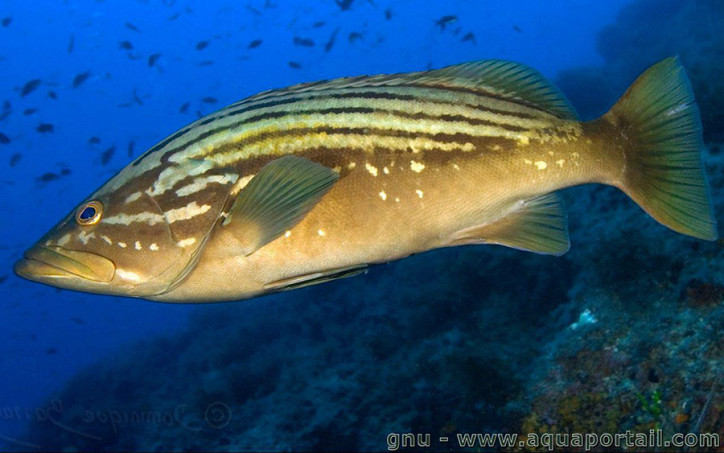
(Goldblotch grouper. Photo © aquaportail.com)
Dusky grouper is caught a little less often. It is one of the most beautifully colored fishes of the family inhabiting the Adriatic Sea. The predator can be up to one and a half meters long and weigh 60 kilograms. Smaller specimens hunt in the coastal zone, as well as in case of most species of groupers.
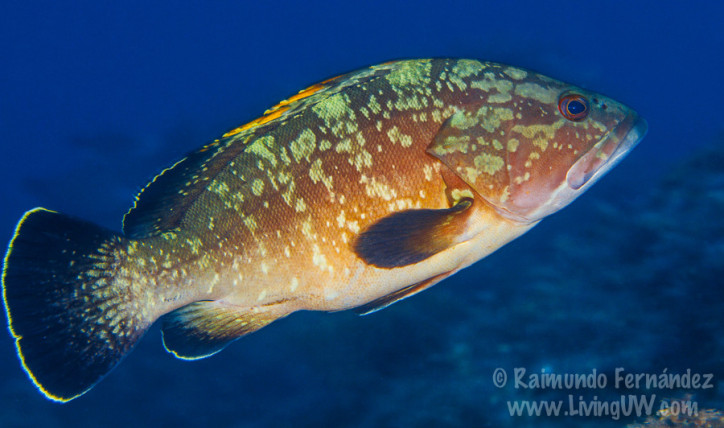
(Dusky grouper. Photo © Raimundo Fernandez. flickr.com/photos/rferdiez)
If you aim at catching a grouper, you will need quite powerful spinning rod and reel. Firstly, your lures can be attacked by fairly large specimens. And secondly, even not the best trophy fish usually attack in close proximity to the bottom and, feeling the unpleasantness of the situation in which they find themselves, try to crawl into the crevices between the stones immediately.
Once in a protected place, the grouper opens its gill covers with the help of the most powerful muscles, and in this situation there is nothing you can do but take a break in playing, waiting for the moment when the fish decides to move to another, more comfortable place.
The larger the grouper and the lighter the tackle is, the less likely it is to see a decent specimen on the shore.
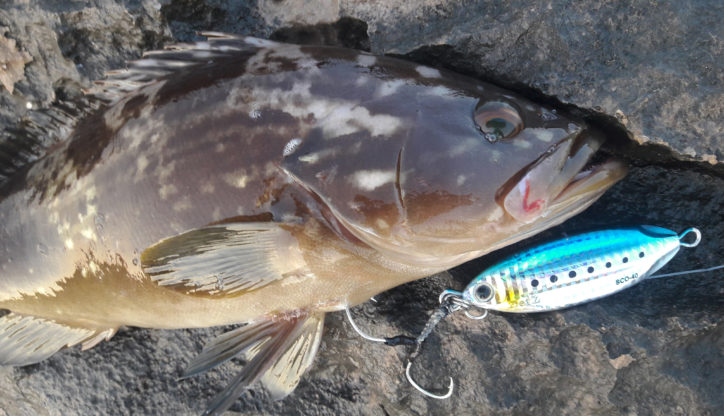
(Goldblotch grouper caught from the shore with a slow metal jig. Photo © adriaticnature)
Since the groupers in the Adriatic are bottom predators, catching them with topwater lures is more likely an accident. You will need quite large soft plastic lures and jigs. “Slow jigs” are obviously the favorite ones of these large representatives of the Serranidae family. But the fish don’t mind biting any other metal jig designed for “fast” retrieve methods and passing by their mouth.
Proper persistence, right choice of the place of fishing and lures can bring you an unforgettable trophy, no matter how big it is.
Don’t forget to pay your attention to the minimum size of groupers allowed to be caught in a particular country. These restrictions are often not the least.
Greater amberjack is a predator that attracts anglers from different countries and makes them go fishing in the Adriatic Sea. Large and strongest fish, the maximum weight of which is more than 80 kilograms, are mainly caught from boats using vertical jigging or live baits, but chances are high that you will catch this powerful fish from the shore.

(Greater amberjack. Photo © NOAA Photo Library. flickr.com/photos/noaaphotolib)
Amberjack dislikes a flat sandy bottom, and, like the groupers, prefers to swim above the rocky bottom.
The best time to catch coronado from the shore is the second half of spring, but the chances of catching it are high in autumn, winter, and summer. Fish with high speed prefer fast retrieves of lures, especially in case of narrow jigs, which are best-in-class in catching these predators.
However, slow movements of soft plastic lures, stickbaits, plugs and inchikus won’t be ignored, if amberjacks are hungry.
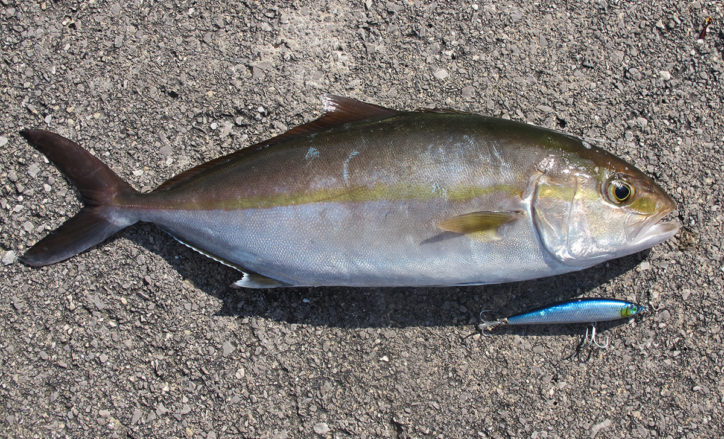
(Small greater amberjack caught from the shore with a stickbait. Photo © adriaticnature)
As in the case of groupers, in different countries there are restrictions as regards the size of amberjacks, which can be withdrawn as a catch. In any case, try to release the fish weighing up to two kilograms back into their native element.
Another predator that can attack your lures both near the bottom and near the surface is a fish that looks unusually and has a fierce (as regards its size and your tackle) retrieving resistance – that is a gray triggerfish.
It can weigh up to 6.2 kilograms and be 60 cm long. Gray triggerfish has very strong jaws and at the same time a very small mouth, which is often the reason for it getting off the hook or ridiculous inability to simply grab the hook of your lure.

(Gray triggerfish. Photo © camping-le-moteno.co.uk)
Gray triggerfish is considered to be a single predator. Sometimes it creates schools. But it is more often found in schools near the coast. If you managed to catch one triggerfish, you can expect the biting of another. Jigs, soft plastic lures, plugs, stickbaits – triggerfishes are relatively omnivorous fish.
It is hardly possible to catch it purposefully. But you can always expect its biting near the bottom covered with mollusks, the main food of triggerfishes. You shouldn’t be surprised if the triggerfish catches your plug near the shore and tries to grab it, a meter away from your feet, and keeps on trying hard. It is a surprisingly reckless inhabitant of the Adriatic Sea, which is most often active in warm months.

(Gray triggerfish caught from the shore with a metal jig. Photo © adriaticnature)
Fishing with spinning rods with topwater lures is the most spectacular. Bluefish is one of the most aggressive Adriatic predators. Its behavior on a fishing cord is the reason why you often don’t known who will win the struggle.
It is a large fish that can weigh more than 14 kilograms. It is a desired trophy of the fishermen who prefer to fish with spinning rods at the Adriatic coast.

(Bluefish. Photo © Rudie H. Kuiter. portphillipmarinelife.net.au)
Bluefish is a menace to all flesh. It will provide you with unforgettable impressions while catching it. The fish attacks the lure and can make astounding jumps over the water, shaking its head and trying to get rid of the inedible object stuck in the toothed mouth. Catching specimens weighing more than 5-6 kilograms is not uncommon in the Adriatic Sea.
Bluefishes are schooling fish that like the parts of the sea where fresh and salt water mix. They swim close to the shore in different seasons and move constantly. Spring, autumn, winter, summer – there is always a spot on the coast where the bluefish is actively feeding. But the spring and autumn months can provide you with the best catches.

(Bluefishes caught from the shore with a topwater lure. Photo © adriaticnature)
Despite the omnivorous nature of the bluefish, which will gladly taste plugs, stickbaits and even jigs from your fishing boxes, the best solution will be checking the activity of the fish using topwater lures.
The predator is more active before evening and in the morning. And if you set your mind on catching it, but you are not sure if there are bluefishes in the chosen location, you shouldn’t spend the whole day desperately trying to catch it from one spot.
Don’t choose small lures and thin fluorocarbon leader – the sawteeth of a large predator won’t forgive you either one or the other.
When the water warms up to its maximum temperatures, schools of the brightest Adriatic predators, which have been given many names, begin to swim closer to the shore. Common dolphinfish, mahi-mahi, dorado are the official names. But no matter how you call this fish, there is no way you mis it up with another fish.

(Mahi-mahi. Photo © teamseafoods.com)
Dorado is one of the fastest growing sea fishes. It lives about four years. These predators manage to reach weights up to 40 kilograms, but specimens weighing over 18-20 kilograms are rare.
If you have a vacation in August-September, and you have a spinning rod, chances are high that you get acquainted with this live gold bar consisting of muscles.
On the one hand, dorados are fish that don’t mind any artificial lure when they are hungry – it doesn’t matter whether it is a plug, popper or metal jig. But, on the other hand, when there is enough food and fish are well-fed, experiments with the contents of the box will be more than welcome.

(Mahi-mahi, caught from the coast with a metal jig. Photo © adriaticnature)
Beaches, marinas, bays, depths under rocky shores – dorados are in the places, where they have something to eat. When you go to the beach with your family in late summer and early autumn, don’t be too lazy and take a spinning rod with lures. And when you see the golden bodies of fish strolling literally under your feet or small fish scattering horror-struck a few dozens of meters from the shore, be ready to cast the rod.
Don’t feel bad, if you come on holiday to the Adriatic Sea in the second half of autumn – at this time the largest specimens of bright predators can be caught from the shore.
In autumn, another predator swims close to the shores. Its silver color seems of no value to jewelers, but it’s as priceless for fishermen as a diamond. It’s leerfish or garrick.
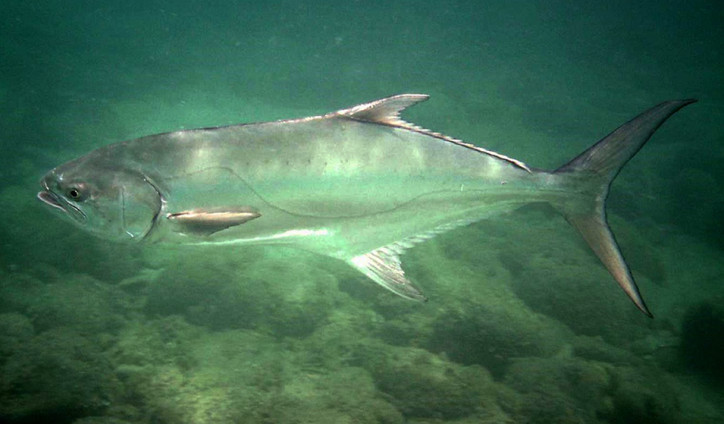
(Leerfish. Photo © Giorgio Vittone. juzaphoto.com)
The fish can weigh up to 50 kilograms. It can bite your lures at any time of the year, however, chances are higher to catch it in autumn, spring and winter.
If in the case of groupers there is an obvious following tendency: the larger the fish is, the further from the coast it swims, this rule doesn’t work in the case of leerfish, and it’s quite possible to catch a predator weighing 10+ kilograms at a distance of a cast. However, it’s rather hard to guess the moment when a school of leerfishes passes the place on the rocks, where you are currently fishing.
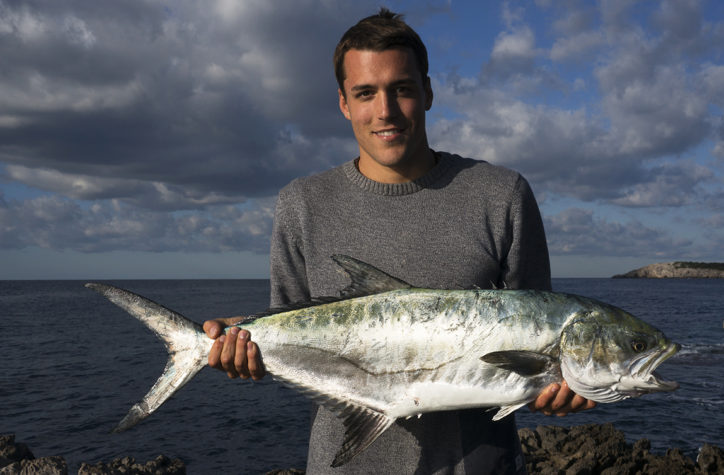
(Leerfish caught from the shore with a metal jig. Photo © adriaticnature)
Catching leerfishes from the motorboat is more predictable. Of course, adriaticnature will pay much attention to boat (“offshore”) sea fishing on its pages. However, being on the shores of the Adriatic Sea during the offseason, you should keep in mind that you can meet the trophy leerfishes, and don’t forget about the power of your tackle to win the fight against a strong predator.
Leerfish is not a demanding fish. Metal jigs, topwater lures, plugs – you just have to be ready for a bite.
At the same time, when schools of leerfishes stroll along the Adriatic shores, large representatives of the mackerel family are pursuing schools of small fish as well.
One of the most popular games while fishing with a spinning rod from the shore is the fish of the Sarda genus – Atlantic bonito.
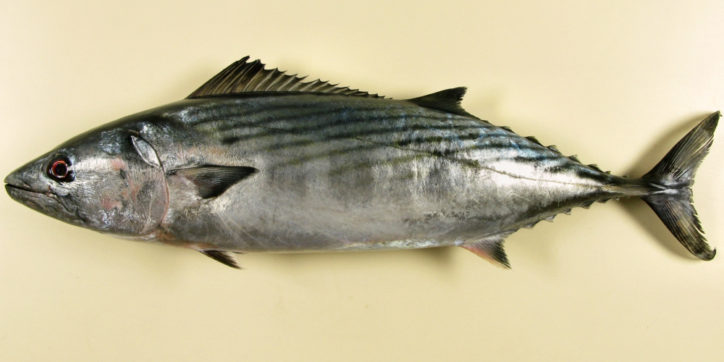
(Atlantic bonito. Photo © Ichthyology Database of the Swedish Museum of Natural History. artedi.nrm.se)
In spring and autumn, these pelagic predators swim closer to the coast, and catching them is purposeful. Although bonitos can weigh up to 11 kilograms, the common “Adriatic” weight rarely exceeds three kilograms. But these three kilograms, even half, is a treat for the angler, providing powerful resistance at the opposite end of the braided fishing line.
These are schooling fish that often manifest themselves as “kettles” near the shore, and seagulls trying to grab small fish, “squeezed out” by bonitos to the surface.
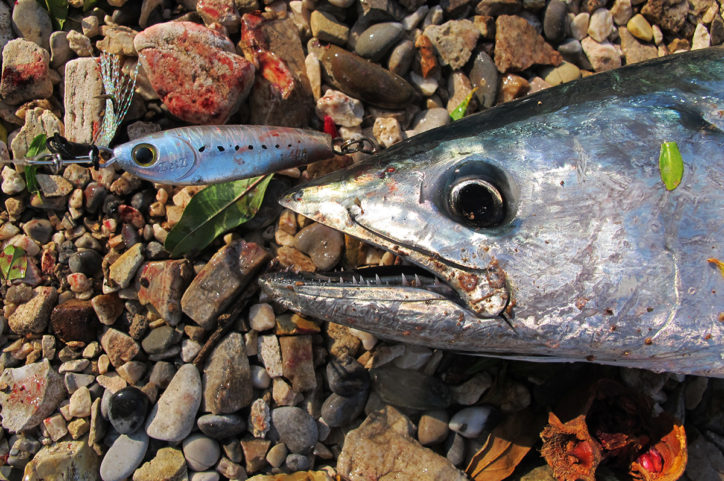
(Atlantic bonito caught from the shore with a metal jig. Photo © adriaticnature)
The toothy relative of tunas may be demanding sometimes. Nevertheless, it willingly responds to the fast retrieve of a small metal jig, to a stickbait smoothly falling in the water, like an autumn leaf, or it aggressively attacks various plugs or small soft plastic lures, cast toward it with the help of bombardas.
Little tunny or false albacore, or little tuna acts in much the same way. It is the most frequent representative of tuna found in the Adriatic. It can weigh up to 16.5 kilograms. It is a desirable target for virtually all Adriatic “shore” fishermen with spinning rods.
Little tunny doesn’t like shallow water, deep water under the rocky shores is its element. Here it feels like a master during the offseason and in winter. No one knows at what point the schools of tunny decide to swim closer to the angler at a distance of a cast, but if you have found accessible deep water close to the place of your rest, check the sharpness of your hooks on the metal jigs.
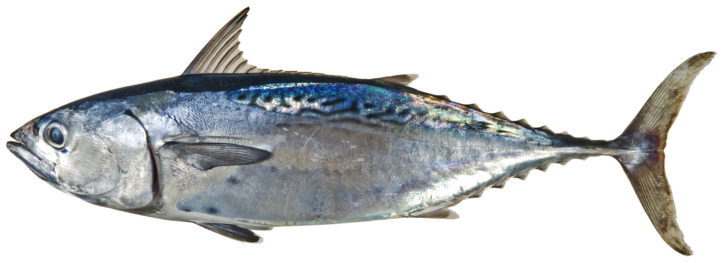
(Little tunny. Photo © commons.wikimedia.org)
Autumn passes of the schools along the rocky shores, starting from the end of August and ending before the beginning of winter, are observed regularly. Spring visits are more whimsical and depend on the often changeable weather and the availability of its food supply.
Tunnies, whatever size they are, are incredibly strong fighters, after the first fight with fish weighing even 2-3 kilograms, you won’t believe that it was able to provide such resistance.

(Little tunny сaught from the shore with a metal jig. Photo © adriaticnature)
Be ready for biting of the fish weighing 7-8+ kilograms. Use rather powerful spinning kits.
Atlantic little tunnies willingly attack jigs, stickbaits, heavy but compact soft plastic lures. They won’t reject walkers with poppers. Predators are usually active at dawn and before twilight.
The Adriatic Sea is amazing. It provides us with all the opportunities to spend a wonderful holiday with the family on its shores, and, at the moments free from rest, is always ready to offer catching of the strongest fish with your favorite tackle. It is ready to let you go away from the gentle beaches and harsh rocks for a couple of hundreds kilometers from its shores to give you some time to enjoy the crazy mountain scenery, to get acquainted with large trout and grayling of the cleanest rivers and lakes of the mainland coastal countries.
adriaticnature completes the article on shore fishing in the Adriatic Sea with this item. Of course, there are more fish species that you can catch from the beaches and rocks than the article describes. You can always find out about them from the new posts on the site or simply follow the constantly updated descriptions of fish species in “The Adriatic Fish. Guide” column, where all inhabitants of the Adriatic Sea will be described in the immediate future.
And, of course, during the holidays no one cancels fishing from motor boats and boats. Atlantic bluefinned tunas, swordfishes, Mediterranean spearfishes and many other predators hunt actively, hidden from us by several kilometers of the water surface. adriaticnature will deal with fishing from boats, the so-called offshore fishing, in other posts.
adriaticnature wishes its readers wonderful trophies, an unforgettable struggle with the Adriatic fishes and the joy of communicating with the beautiful sea.
And of course, we hope that those who want to experience the biting of the largest predator of the Adriatic Sea, Atlantic bluefin tuna, will be lucky.
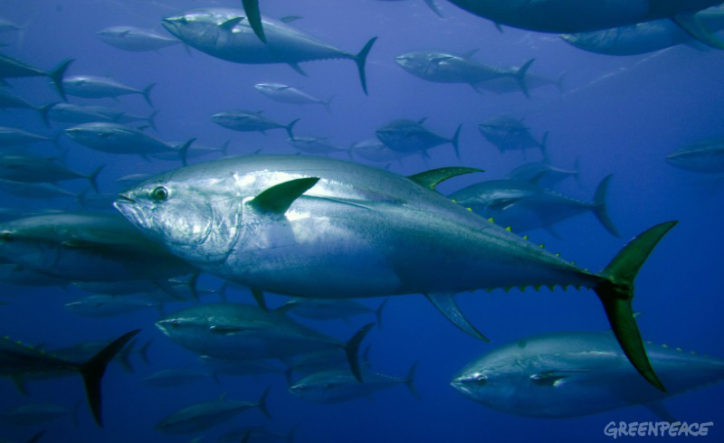
(Atlantic bluefin tuna. Photo © Greenpeace / Gavin Newman. greenpeace.org)
Atlantic bluefin tuna can weigh more than 680 kilograms and often hunts in the coastal zone. 680 kilograms – it is hardly possible to see such a specimen, but there is always the possibility of meeting a fish weighing up to 100 kilograms. Unfortunately, chances of seeing “bluefin”, when fishing from the shore without proper tackles and preparation, are not so high. But if the bite happens, the memories will definitely remain for a lifetime.
(Screaming drag. Yellowfin tuna hook up. Video © Dennis Verreet)
If you have any questions, you can always contact adriaticnature via email and our Facebook and Instagram pages.
Bring home a good catch!